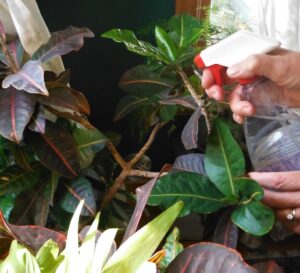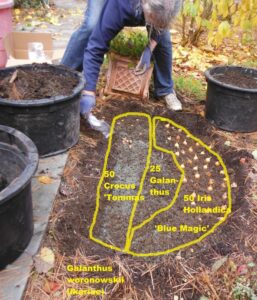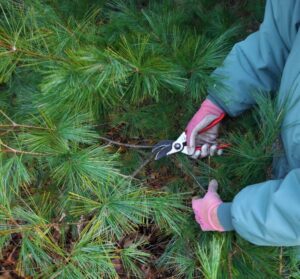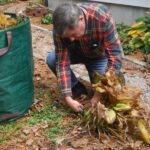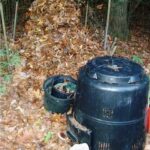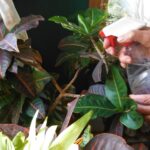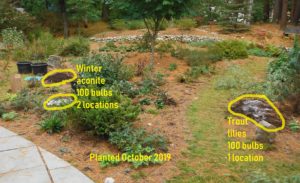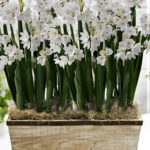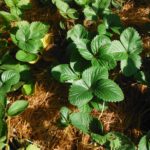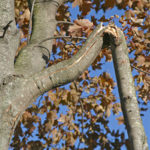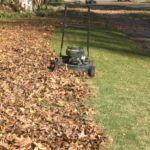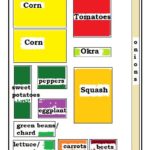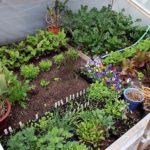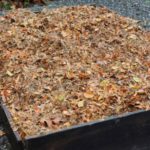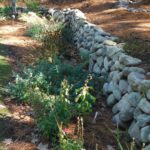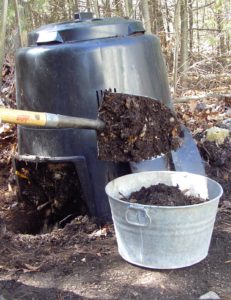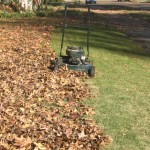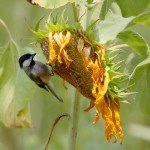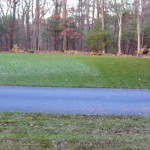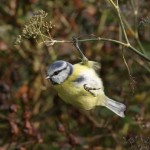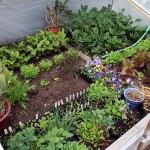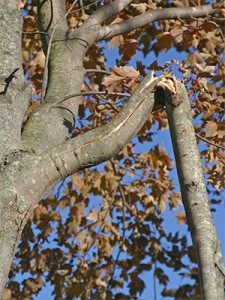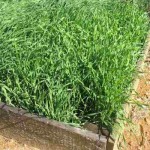Horticultural Hints – November
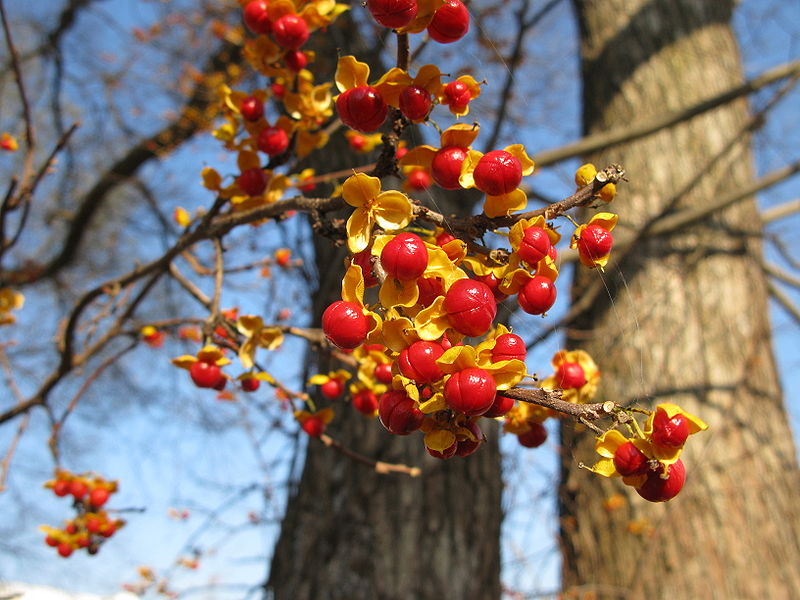 A Not-So-Sweet Vine. If you come across bittersweet, look at it carefully. The oriental bittersweet (which is what we usually see and is shown at right) is a highly invasive intruder and should be cut down, bagged and sent to the incinerator. It covers and kills trees in the forest and around the edges of fields. It is illegal to sell items made of oriental bittersweet. The decorative wreath on your front door will be eaten by birds and then many bittersweet plants will invade your garden and your neighborhood for years to come. The difference between the nasty oriental and the friendly native bittersweet is remembering that on the native plant, the red berries hang in clumps while they are spaced along the vine on the oriental species.
A Not-So-Sweet Vine. If you come across bittersweet, look at it carefully. The oriental bittersweet (which is what we usually see and is shown at right) is a highly invasive intruder and should be cut down, bagged and sent to the incinerator. It covers and kills trees in the forest and around the edges of fields. It is illegal to sell items made of oriental bittersweet. The decorative wreath on your front door will be eaten by birds and then many bittersweet plants will invade your garden and your neighborhood for years to come. The difference between the nasty oriental and the friendly native bittersweet is remembering that on the native plant, the red berries hang in clumps while they are spaced along the vine on the oriental species.
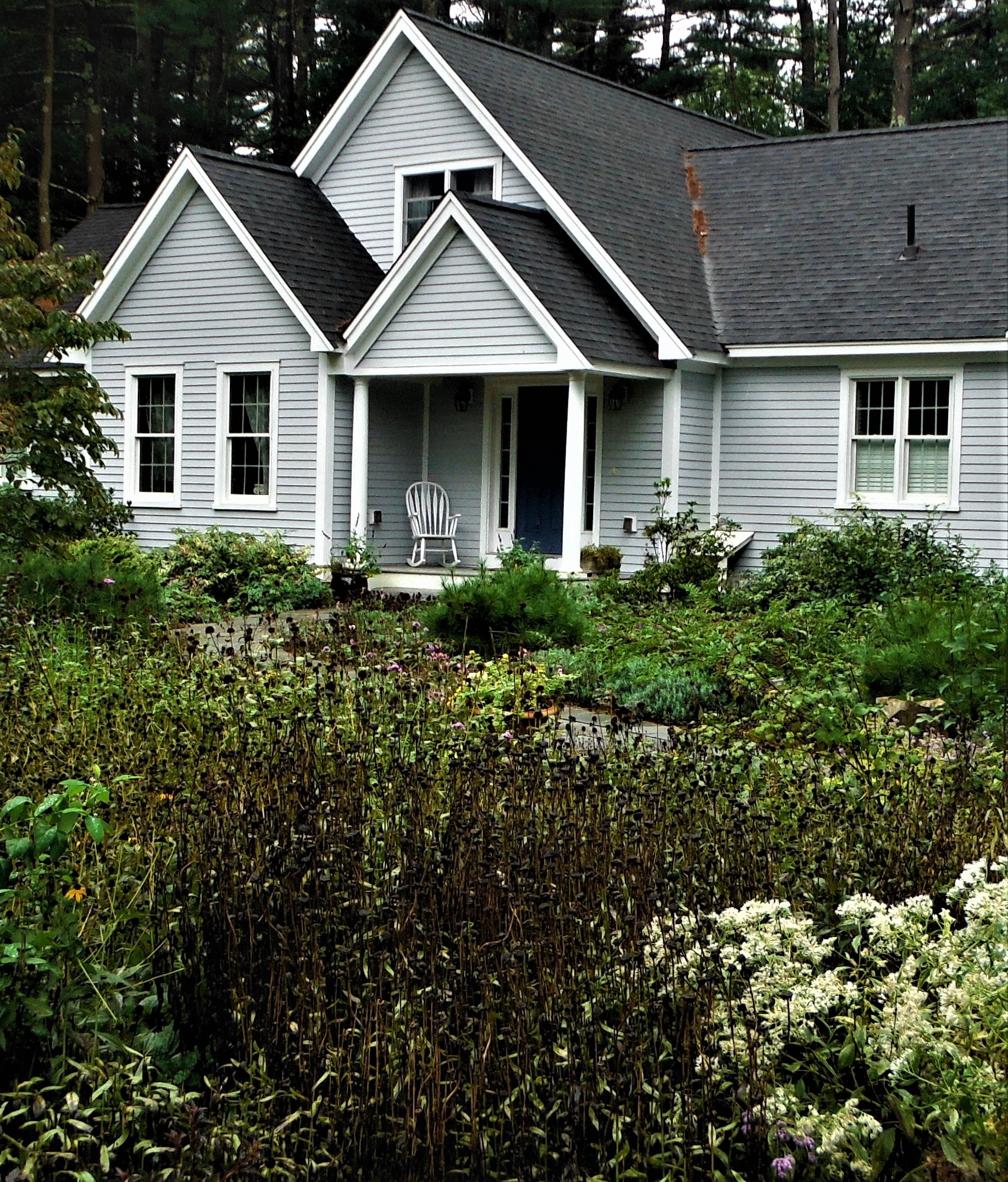
The rudbeckia and black-eyed susans in my garden will be left up for the winter in order to provide seed for over-wintering birds
Plant more spring bulbs. The catalogs and garden centers now have bulbs discounted, and it’s not too late to plant them for spring. You’ll be glad you did not just next April, May, and June, but for years to come and your bulbs multiply each passing year.
Garden clean-up—or not? If the perennials and annuals in your garden were not affected by disease, consider leaving seed heads of black-eyed susans, cone flower and similar plants standing. They provide an important food source for the birds that winter over here. Cleanup can be finished in the spring, and you get to enjoy the birds throughout the winter.
Don’t forget to clean the vegetable garden. Removing all annual plants, vines and fallen fruit before adding any mulch, compost or planting a cover crop on your garden is always good gardening. Your vegetable garden should be stripped of all annual plants. Only perennials such as rhubarb should remain along with the garlic you planted last month to be harvested in June. You will be getting rid of disease and possibly insects before you begin gardening next spring.
Continue to remove leaves. The best and easiest way to get them off your lawn, and make them work for you, is to mow them into the lawn with a mulching mower. If you bag mown leaves, use them to cover flower and vegetable beds, to mulch around the base of trees and shrubs and finally to create leaf mold or compost for future garden use.
Evergreens give twice. Late this month, plan to prune some of your evergreens. The cuttings can be used to make holiday arrangements for the house, fill window boxes or outdoor containers. And don’t be concerned if pine or arborvitae are dropping some of their needles now. This is a normal part of their renewal. All evergreens shed their leaves at some time, just not all at once like deciduous trees.
Indoor Gardening. This is the rest period for indoor plants. Stop regular watering of cacti and most succulents during the winter months. Check monthly and water only if you see signs of wilting. Other house plants need less water to go along with the reduced sunlight and cooler temperatures they are experiencing. Eliminate fertilizer for the resting plants. Mist or add humidity with pebble trays for plants uncomfortable with dry air that comes with central heating.
Repellents. It’s time to spray your garden. Deer and other foragers (large and small) now find less to eat in the woods and fields and return to the buffets we call our gardens. Animal repellents smell bad to us for only a short time but the vile taste lingers teaching the animal to look elsewhere for food. Repellents can be applied anytime the temperature is above 40° and should be re-applied every three to four weeks throughout the winter.
Finish planting your spring bulbs while they can still begin to set roots. As you do, photograph the site so you can remember what you planted, and where.
Save your ashes. If you have wood fires, ashes should be saved to place around plants that prefer sweet (not acidic) soil, or to place over areas where you have planted spring bulbs. Always leave the ashes in the fireplace or outside on the ground, not the deck or porch, in a metal bucket until they are cold. Do not use the ash from man-made fireplace logs or from a charcoal grill.
Late this month plan to prune your evergreens. The cuttings can be used to make holiday arrangements for the house, fill window boxes or outdoor containers. And don’t be concerned if pine or arborvitae are dropping some of their needles now. This is a normal part of their renewal. All evergreens shed their leaves at some time, just not all at once like deciduous trees.
Plant up bulbs for forcing. Paperwhites need no chilling period, make great Christmas gifts and brighten everyone’s home during the winter months.
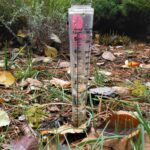 Welcome the rain and snow. The best news for gardeners following a summer-long drought has been the rains (and even some snow) that arrived late in October. While drought maps still show much of New England as abnormally dry, November should supply sufficient soil moisture to see our plants through the winter. However, hoping for more rain (or snow) before the ground freezes would not be out of order.
Welcome the rain and snow. The best news for gardeners following a summer-long drought has been the rains (and even some snow) that arrived late in October. While drought maps still show much of New England as abnormally dry, November should supply sufficient soil moisture to see our plants through the winter. However, hoping for more rain (or snow) before the ground freezes would not be out of order.
Finish the clean-up. Those non-woody plants collapsing around your garden need to be cleaned up now and, by ‘cleaned up’, they need to be cut close to the ground, bagged, and evicted from your property. Your garden will look better, and it ensures you are removing any disease or insect eggs that might winter over.
Compost! Leaves and other clean foliage should go into your composter or compost heap. Leaves run over by the lawnmower are a great source of nutrients for new plantings and existing lawns. Spread mulched leaves over old garden beds. The leaves’ nutrients will move toward the roots from the freezing and thawing action of the soil.
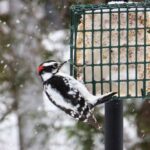 Time to feed the birds. Winter is tough on the birds that don’t migrate south. If you enjoy the color and antics they bring to your winter garden, welcome them with food and water. Choose the food that will attract the birds you prefer, or be a generous generalist and see who appears. The reward for being a big-hearted host will come next spring as those same birds will repay your hospitality by eating insects and insect eggs that could bedevil your garden.
Time to feed the birds. Winter is tough on the birds that don’t migrate south. If you enjoy the color and antics they bring to your winter garden, welcome them with food and water. Choose the food that will attract the birds you prefer, or be a generous generalist and see who appears. The reward for being a big-hearted host will come next spring as those same birds will repay your hospitality by eating insects and insect eggs that could bedevil your garden.
Are your houseplants winter ready? With your home’s heating system now running full time, your house plants will need more water to compensate for much lower indoor humidity. Check them frequently for dry soil. They will also appreciate regular mistings.
Decorating for the holidays? If you plan to put lights on outdoor trees or shrubs, do it now. Why? Because the branches become more prone to breaking as the weather turns colder. After the holidays, leave the lights in place until you have a warm day when you won’t risk damaging branches when you remove the strands.
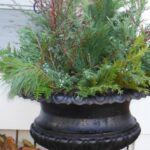 When you cut greens for indoor or outdoor displays, remember those basic rules for pruning so you do not accidentally transform a handsome tree or shrub into a landscape liability. If you like bright, berry accents among your greens, use artificial ones instead of taking berries from the birds.
When you cut greens for indoor or outdoor displays, remember those basic rules for pruning so you do not accidentally transform a handsome tree or shrub into a landscape liability. If you like bright, berry accents among your greens, use artificial ones instead of taking berries from the birds.
For bulbs, it’s now or never. Early November is your last call to get spring blooming bulbs in the ground. As a general rule, bulbs are planted three times as deep as their largest dimension (measured from the top of the bulb). Add lime on top of the soil to confound squirrels, chipmunks and others who would dig the bulbs for dinner. The lime also acts to sweeten our generally acidic soil which bulbs prefer. And take photos of the planting areas so you know what you put where your bulbs next spring.
Sweet scents for the holidays. Purchase bulbs now that you would like to give as Christmas gifts. Amaryllis and paperwhites are both easy to force. Paperwhites can be planted in soil or in small pebbles just deep to allow the roots to provide a sturdy base for the flowers. Planted by November 14, they should provide flowers for Christmas. Amaryllis take longer to bloom, up to 8 weeks, but also last longer once in bloom.
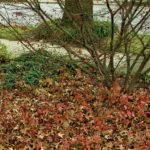
Those autumn leaves under your shrubs will become the winter home for beneficial insects. Leave them in place!
Leave some leaves. Give yourself a break on (some) fall clean up. Stripping the garden bare is not good for the soil. Some plant (clean, not diseased) material left in place helps to hold the soil. A mulch of shredded leaves (from your lawn mowing, for example) will prevent soil erosion in beds.
Rose care. Now that your roses have blooms their last for this season, make certain they have a safe winter. Cut back long canes on roses to prevent damage from wind whipping them. Protect the remaining canes with a wire cage filled with leaves. Your roses will thank you next spring!
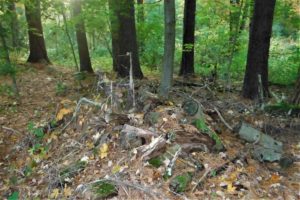 Thanksgiving for your garden. As you prepare for Thanksgiving and winter, remember wildlife needs a place to winter also. If you have room on your property, a brush pile gives birds shelter from both severe weather and predators. Dead flower stalks that have seeds are natural birdfeeders, leaving them in place provides food.
Thanksgiving for your garden. As you prepare for Thanksgiving and winter, remember wildlife needs a place to winter also. If you have room on your property, a brush pile gives birds shelter from both severe weather and predators. Dead flower stalks that have seeds are natural birdfeeders, leaving them in place provides food.
Let them rest. Stop fertilizing houseplants until next February – unless you keep them under lights. With late autumn and winter’s lower light levels, houseplants enter a resting phase. It will also help your houseplants if you keep your home on the cooler side (or place plants in a cooler room) and keep your houseplant’s leaves clean.
Some flower seeds need a winter outside to germinate. Sow seeds of calendulas, cosmos, cleomes and snapdragons outside. If you garden to attract birds and butterflies, also sow Asclepias (butterfly weed) and milkweed seed now.
Did you grow strawberries this year? To protect them against winter damage, cover strawberry beds with a straw, pine needles or other loose, coarse material. Do not use tree leaves which will pack down.
Your plants may still need water. New England was drenched with water in late October, but soil moisture levels were low from July until mid-month, putting much of the region into a moderate drought as indicated by the Drought Monitor. All woody plants, trees and shrubs, need water now to fill their roots before winter. Once the ground freezes, the plants are in the Sahara as far as access to moisture—no matter how much snow we get over the winter.
Clean-up. Our late-October nor’easter left a lot of extra clean-up for many of us. While a maple tree across the power lines is hard to miss, lesser damage can have long-term consequences. Carefully check trees and shrubs for branches broken by the wind or falling debris. Prune them out now; don’t leave them until spring. The clean cut you make now will heal faster and you will protect the plant from further damage by winter storms. Pick up the downed branches and, if you can, have them chipped to use as mulch.
Those leaves are your friends. The late-October nor’easter accelerated the seasonal leaf drop across all of New England. Don’t be discouraged and rake the leaves away. Any leaves not chopped up the first time the lawn is mowed will be taken care of as you continue mowing the lawn until the ground begins to freeze at the end of the month. Remember the leaves will add nutrients and improve the soil with no cost and very little extra work on your part. Leaves that fall on driveways and sidewalks can be raked up for use in compost bins, or chipped with a mower and used under shrubs and around perennials for winter protection.
Map your Garden. Before you forget where you put new plants this year, map your garden. Do it by sections if your garden is large. Make it easy on yourself by giving parts of the garden names: ‘right of the front door’, or ‘near the Cornus florida’ to designate spaces. Next spring, your map will make it easier to figure out which returning perennial is which. And also do a sketch of your vegetable garden so that next spring you don’t put the tomatoes or peppers, lettuce or beets exactly where they were this year. Rotating planting areas helps to prevent a build-up of disease in the soil.
Not All Garden Crops Die with the First Frost. The vegetable garden may still have lettuce, spinach, leeks, Swiss chard, turnips, carrots or Brussels sprouts growing. Enjoy the fresh produce into the winter by keeping a cold frame going. Once you have put the cover over it, you will need to water the vegetables inside for them to continue growing. And, if you have ever considered garlic in the garden, now is the time to plant it. The bulbs will sprout roots now and take off as soon as the soil warms next spring. You’ll harvest garlic in June as long as you remember not to plant supermarket garlic which has been treated not to sprout.
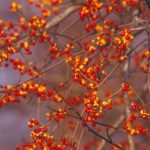
Oriental bittersweet is an invasive vine in New England. Its distinctive berries are highly visible in November.
The Not-So-Sweet Vine. The cold weather means you can enjoy a walk in the woods and fields. If you come across bittersweet, look at it carefully. The oriental bittersweet (which is what we usually see) is a highly invasive intruder and should be cut down, bagged and sent to the incinerator. It covers and kills trees in the forest and around the edges of fields. It is illegal to sell items made of oriental bittersweet. The decorative wreath on your front door will be eaten by birds and then many bittersweet plants will bedevil your garden and your neighborhood for years to come. You can tell the difference between the nasty oriental and the friendly native bittersweet by remembering that, on the native plant, the red berries hang in clumps while they are spaced along the vine on the oriental species.
Indoor Gardening. Your indoor plants should have somewhat adapted to the loss of light and the dryer air they encountered after being moved in for the winter back in September. The rule now is to use less water and no fertilizer until early February. Houseplants will not begin growing again until they get more light. Keep humidity up by clustering plants and placing them on trays of pebbles to which you regularly add water to just below the bottom of the pots. If you grow cactus, stop all water during through this period because they plants are naturally adapted to a winter drought.
Spring bulbs. Plan ahead for wonderful sweeps of color throughout the spring. In other words, finish planting your bulbs this month. The work you put into planting will bring many years of joy as the first flowers of spring guarantee an end of the New England winter gardener’s blues. Some bulbs are still available at nurseries. Also check online specials from reputable bulb companies where you might find bulbs you didn’t know about before, and won’t want to live without after you see them bloom in 2017.
Good housekeeping. It’s time to finish cleaning up the garden. Here are the top things to do this month:
Your vegetable garden should be stripped of all annual plants—only perennials like rhubarb should remain along with the garlic you planted last month that will be harvested in June. That makes this a good time to improve the garden by putting a layer of manure or compost – or even shredded leaves – over the soil. By spring the manure will have aged, the compost been somewhat worked in by freezing and thawing, and the leaves broken down into the soil. All corn stalks, tomato plants and any plant that had disease should be taken to the dump, not the compost heap.
Ornamental gardens also need a clean-up. All annuals should be pulled and composted. Perennials require a series of decisions. Do they appear to be diseased? Cut the foliage down to 3 or 4 inches above the crown (you don’t want to risk cutting into the crown and damaging the plant). If the plant is not diseased, you have a choice: you can cut the foliage down and put it into your compost, or you can leave it there to benefit wildlife. Birds will eat the seeds on the tops of stalks throughout the winter. Native bees will winter over in the hollow stems of many flowers. Some butterfly and other beneficial insects winter over in the leaf debris at the base of the plants or under shrubs. After decades of being in the ‘cut it all down’ school, I now know better, and feel guilty about my ‘thorough’ clean-ups of past years. My garden might look a little messy to some, but in the spring we all will benefit from the early pollinators that will hatch.
Winter mulch. Any mulch also gives your plants a better chance of coming through the winter. The problem for hardy plants isn’t the cold, but the freezing and thawing we often experience. A layer of mulch added to plants when the ground has frozen, will keep the soil cold enough to prevent the thawing and subsequent heaving out of the soil to die when the temperature drops again. Mulch added now can just be fluffed in the spring (but do so carefully to avoid damaging any new shoots), reducing that chore at a busier time of year.
New garden beds. Now is the time to begin any new beds you want for next season. If grass covers the site, remove it from the soil (3-4 inches) turn it over so the green part is on the bottom. Next bury it under six sheets of newspapers (not glossy magazines) and top with 6 inches of shredded leaves, soil and, finally, mulch. In the spring your garden will be ready to plant.
It’s really fall now. The leaves are going, going and soon gone. But keep their goodness around. Mow them into the grass to feed the lawn areas or, if you must gather them up, put them in your compost pile. Shredded leaves will not suffocate grass or other plantings. Chipped or shredded leaves will compost even faster and be at work improving your soil and helping to feed you plants next spring and for years to come. You can also put shredded leaves under trees and shrubs and over perennial beds to help protect them from freeze and thaw cycles.
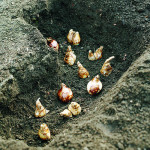
Digging a trench for bulbs ensures better drainage and placement control than planting each bulb individually
Planting bulbs. If you are like me you may remember where you planted bulbs, but not what variety or even how many. This year I’m planting over 1600 bulbs on my new property. As you plant, make notes (“200 narcissus Arkle along front wall, 100 narcissus Hawera by viburnums, 50 Hyacinth Blue Note along the patio…”) then, in the spring, you can judge who looks the best, did the best or maybe did not grow the way you hoped.
Cleanup or not? Remove plant material yes, but also leave some behind. The seed heads of many perennials such as rudbeckia (black-eyed susan), native grasses, monarda (bee balm) and eupatorium (Joe Pye Weed) provide fall and winter seeds for the birds. You may have a few more volunteer plants in the spring, but you’ll have more hungry birds ready to eat the new crop of insects that will be hatching.
Container gardens. Our summer containers are gone, our fall containers won’t be looking so good after a couple of hard frosts. It’s time to empty them out and clean them for next year. Reusing old potting mix may seem the frugal thing to do, but it not built to last for years and may harbor diseases or insect eggs. Toss it and clean the container by brushing out the remaining soil and then washing it in a 10% bleach solution (a cup of bleach to a half gallon of water). Allow it to dry and then store it in a garden shed, garage or basement and you are ready to plant it again in the spring.
If you have containers with evergreens planted in them, keep watering them until they freeze to help the plants survive the winter. Use cut greens to fill pots too large to move to help brighten the area for winter. But remember you will still need to clean the pot before putting in new plants in the spring.
Summer bulbs. All your summer bulbs – gladioli, dahlias, cannas and the like – should have been dug, dried off, bagged and tagged (what color was that one?) and stored for the winter. There’s still time to put in spring blooming bulbs. The daffodils, crocuses, hyacinths and other spring beauties you put in now will greet you with welcome color come April and May. Just remember that the deer and rabbits think tulips are their Easter candy so choose your planting location with protecting them in mind.
Lawns, leaves and winter. It isn’t too late to get an inexpensive soil test (http://soiltest.umass.edu/ordering-information) and then do some good for your lawn. Results come back quickly at this time of year and tell you how to fix problems. If your test shows that the soil in your lawn or flower beds is getting too acidic, a common problem in New England, November is an ideal time to put down the recommended application of lime. By spring it will have worked its way into the soil giving your plants a head start on the 2015 growing season. And mow, don’t rake in, those leave! Only leaves left to mat on the lawn are bad. Those chopped up by a mower add back nutrients to soil.
Garden clean-up—or not? If the perennials and annuals in your garden were not affected by disease, consider leaving seed heads of black eyed susans, cone flower and similar plants standing. They provide an important food source for the birds that winter over here. Cleanup can be finished in the spring, and you get to enjoy the birds throughout the winter.
Bulbs for winter and spring. Last call for digging up tender summer bulbs such as dahlias, begonias and tropicals like caladium and cannas. Planting bulbs such as tulips, crocus, hyacinths and daffodils should be well underway. Don’t add any fertilizer to the hole when you plant spring bulbs. They will be happier if you place a little grit (available from farm stores) or small stones (from Home Depot-type stores) under and around them. The hard material serves two purposes—deterring animals that go after the bulbs and aiding drainage, since few bulbs will tolerate wet sites.
Clean Up Continues: Our frost-free days ended abruptly in late October so now there is no longer any excuse to delay cutting down your spent annuals and perennials. Compost healthy foliage, send those that suffered from disease to the dump.
If you wrap your needled evergreens for winter, skip the burlap and use bird netting. The object is not to protect the plants from the cold, but to protect the branches from being splayed or broken by heavy snows. The netting will do that while allowing you to enjoy the beauty of the evergreens.
Still Mowing. Keep mowing the lawn both to chop up leaves and to keep the grass in line. As the days get colder, drop the mower height to two inches so the grass is less likely to suffer snow mold over the course of the winter.
You can get two chores done at once by adding a grass catcher as you mow an un-raked lawn. Mowers do a great job of chopping up leaves, which can then be spread into flower beds or under shrubs and trees. Chopped leaves won’t blow over the course of the winter. By spring, they will have broken down, enriching the soil and feeding your plants.
Not All Garden Crops Die with the First Frost. The vegetable garden may still have lettuce, spinach, leeks, Swiss chard, turnips, carrots or Brussels sprouts growing. Enjoy the fresh produce into the winter by keeping a cold frame going. Once you have put the cover over it, you will need to water the vegetables inside for them to continue growing.
Put a mulch of straw over the strawberry beds to protect them throughout the winter.
Clean-up and bury or compost all dropped apples and other fruits to limit the spread of disease. Wrap fruit tree trunks with plastic tree guards to protect against damage by rabbits, rodents and others who would damage the trees’ bark.
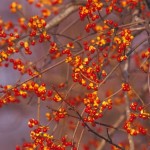
Oriental bittersweet produces flowers and berries along the length of the vine. Domestic bittersweet produces clusters of berries.
The Not-So-Sweet Vine. The cold weather means you can enjoy a walk in the woods and fields. If you come across bittersweet, look at it carefully. The oriental bittersweet (which is what we usually see) is a highly invasive intruder and should be cut down, bagged and sent to the incinerator. It covers and kills trees in the forest and around the edges of fields. It is illegal to sell items made of oriental bittersweet. The decorative wreath on your front door will be eaten by birds and then many bittersweet plants will bedevil your garden and your neighborhood for years to come. You can tell the difference between the nasty oriental and the friendly native bittersweet by remembering that, on the native plant, the red berries hang in clumps while they are spaced along the vine on the oriental species.
Indoor Gardening. Your indoor plants should have somewhat adapted to the loss of light and the dryer air they encountered after being moved in for the winter back in September. The rule now is to use less water and no fertilizer until early February. Houseplants will not begin growing again until they get more light. Keep humidity up by clustering plants and placing them on trays of pebbles to which you regularly add water to just below the bottom of the pots. If you grow cactus, stop all water during through this period because they plants are naturally adapted to a winter drought.
Clean-up. Sandy has left a bit of extra clean-up this year for many of us. Carefully check trees and shrubs for branches broken by the wind or falling debris. Prune them out now; don’t leave them until spring. The clean cut you make now will heal faster and you will protect the plant from further damage by winter storms. Pick up the downed branches and, if you can, have them chipped to use as mulch.
The storm accelerated the leaf drop. Don’t be discouraged and rake the leaves away. Any leaves not chopped up the first time the lawn is mowed will be taken care of as you continue mowing the lawn until the ground begins to freeze at the end of the month. Remember the leaves will add nutrients and improve the soil with no cost and very little extra work on your part. Leaves that fall on driveways and sidewalks can be raked up for use in compost bins, or chipped with a mower and used under shrubs and around perennials for winter protection.
Despite all the rain we received as part of the storm, don’t forget to keep watering trees, shrubs and newly planted perennials. The water they take up now has to support them through the winter. Once the ground freezes, your trees and shrubs will have no access to water until the spring thaw.
Spring bulbs. It’s time to get any remaining bulbs in the ground. It is very important to put them in deeply enough to allow the roots to grow before the ground freezes. And remember to protect them against hungry rodents by adding lime in the hole with the bulb and again on top after you finish planting. Bulbs are still available at some nurseries as well as from on-line catalogs. Start planting paperwhites every two weeks for a bloom from Christmas on through the winter.
Houseplants. Many houseplants are not very happy now. After the move inside, light levels dropped – dramatically in many cases. And, as our furnaces came on, the humidity levels followed suit. Don’t compound their problems by watering too heavily. The plants are going into a resting phase during the dark winter months and need less water. Check with your finger before watering to prevent saturating them. Unless you are growing your plant under lights or preparing it for the Boston Flower and Garden Show amateur horticulture division, don’t try to promote growth by feeding them now.
Vegetable Garden. Finish the clean-up by taking away (or burning) any plant material possibly infected with disease or insects. Tilling the garden now will turn up hibernating insects to be eaten by birds or killed by cold. A cover crop of rye or oats or a commercial blend will hold the soil in place and add organic material when you turn it under in the spring.
And, if you have ever considered garlic in the garden, now is the time to plant it. The bulbs will sprout roots now and take off as soon as the soil warms next spring. You’ll harvest garlic in June as long as you remember not to plant supermarket garlic which has been treated not to sprout.
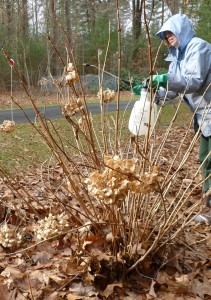
Spraying with a commercial mixture of putrefied eggs and garlic will help deter deer from eating shrubs’ buds
Repellents. It’s time to spray your garden. Deer and other foragers (large and small) now find less to eat in the woods and fields and return to the buffets we call our gardens. Animal repellents smell bad to us for only a short time but the vile taste lingers teaching the animal to look elsewhere for food. Repellents can be applied anytime the temperature is above 40° and should be every three to four weeks throughout the winter.
The Gardening Season Isn’t Over! The snow has made a dramatic first appearance in New England, which should be a wake-up call to finish winterizing the garden. There are many warm days ahead so keep mowing the grass until it stops growing — usually around Thanksgiving. Remove all diseased vegetation from garden beds, as well as any that may be infected with insect pests, such as irises borer eggs in the leaves. This is still a great time to divide overgrown perennials and groundcovers. They can planted in new areas, shared with friends or donated to local garden clubs for their spring plant sales. As you work, use one container for “clean” debris and a second one for diseased or infected material, so you can easily discard the one and compost the other.
Prune any broken or damaged branches now. Ragged breaks and tears are an opportunity for insects and disease to harm an otherwise healthy tree. This early storm did serious damage in some areas. It is best deal with before it is compounded by future storms. Remove downed branches (and trees) while you can.
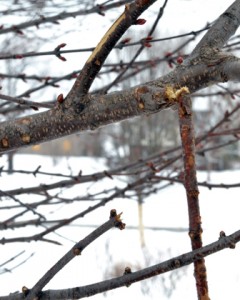 Compost! You’ll have lots of clean debris from your garden clean-up. Rather than sending it to the dump, start or add to a compost pile. Layering greens (the fresh cut materials, kitchen debris) with the brown (dead plants and leaves) will speed the creation of compost, even over the winter. You can use closed bins, open bins or even an out-of-the-way pile. If you must rake leaves, rather them mow into the lawn, add them to the compost pile or make a large pile of leaves. Leaf mold (partially composted leaves) can be used to improve soil and as mulch on garden beds.
Compost! You’ll have lots of clean debris from your garden clean-up. Rather than sending it to the dump, start or add to a compost pile. Layering greens (the fresh cut materials, kitchen debris) with the brown (dead plants and leaves) will speed the creation of compost, even over the winter. You can use closed bins, open bins or even an out-of-the-way pile. If you must rake leaves, rather them mow into the lawn, add them to the compost pile or make a large pile of leaves. Leaf mold (partially composted leaves) can be used to improve soil and as mulch on garden beds.
Build your soil. Autumn is a great time to build your soil. Start with a soil test from the UMass Extension Service. It will tell you the steps you need to correct any problems. If your lawn or garden is acidic, you can add lime anytime throughout the fall and winter and have the problem corrected before spring. If you lack organic matter, the finished compost from your compost bin is an excellent addition. Rake a thin layer (1/2 inch) over a lawn or add it to established gardens as a winter mulch. Spread over gardens after the ground has frozen; it also helps to protect against heaving during winter thaws.
Start new beds. Sod can be removed and fresh manure or leaf mold added to increase organic material, water retention and friability of the soil. Don’t have the time or energy to remove sod? Lay a thick layer of newspaper or cardboard over the area you want to plant next spring, top it with soil and mulch. The grass, weeds or other unwanted material below will die and the area will be plantable in the spring.
Keep planting bulbs. Bulbs are a great investment because their colorful spring displays last year after year. Think in terms of sweeps of color: forgo rows of single bulbs in favor of more attractive mass plantings. Paperwhites intended for the holidays should be planted in pots (indoors, of course) in mid-November.
Continue watering trees and shrubs, particularly the newly planted, until the ground freezes to prepare them for the drought we call winter.
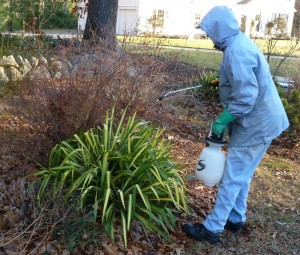
Spraying with a commercial mixture of putrefied eggs and garlic will help deter deer from eating shrubs’ buds
Deer and other unwanted guests. The garden may look bare to you, but deer and rodents still think of your yard as a source of dinner. They’ll eat the leaves of evergreens, growing tips of branches and the buds of next spring’s flowers. When they eat the bark, they’re killing the tree or shrub. Spray with repellents, put up fencing, or do whatever it takes to keep vermin at bay.
Indoor Gardening. This is the rest period for indoor plants. Stop regular watering of cacti and most succulents during the winter months. Check monthly and water only if you see signs of wilting. Other house plants need less water to go along with the reduced sunlight and cooler temperatures they are experiencing. Eliminate fertilizer for the resting plants. Mist or add humidity with pebble trays for plants uncomfortable with dry air that comes with central heating.
The flower show is coming! Don’t forget to check the Amateur Horticulture schedule for Blooms! at the Boston Flower and Garden show to be held next March. You may well have a blue ribbon winner growing on your windowsill. Pamper it this winter and collect the ribbon in March.
Clean up, clean up, clean up! While it is still pleasant to work outside, remove this year’s plant debris from garden beds. Taking away dead stalks and leaves will remove many possible sources of disease if you had problems this year. Many pests lay their eggs in the leaves (such as iris borers) and stalks (like corn borers) of their hosts. Sending the debris to the trash or a burn pile means fewer insects next year.
Leaves in beds can stay put for the winter — after you’ve cleaned out the dead perennials and any weeds trying to winter over. If you have the time, rake them out onto the lawn, chip them with your mower or chipper and return them to the beds. By spring, they will have become compost. Even un-chipped leaves will help protect the plants from winter freezes and thaws. This is particularly important for anything planted this year and vital for those planted this fall.
Keep mowing the lawn. By now your mower blade should have been lowered to approximately two inches. If you have not fertilized, a light application of fertilizer that is not high in nitrogen (the first number on the front of a fertilizer bag ) but also contains phosphorus and potassium (the second and third numbers) is appropriate now. You are encouraging the grass to concentrate on growing roots.
Don’t be afraid to continue mowing leaves into the lawn no matter how deep those leaves are; they will compost into the soil over the winter. Oak leaves are more acidic than pine needles so a week or two after you fertilize, put down lime over your lawn if many of the leaves are from oaks.
This is a good time to move shrubs. After the leaves have dropped is a good time to relocate old shrubs to new homes, (or to add new shrubs). When moving an old shrub, create its new hole first (a saucer not a teacup). Start digging outside the dripline of the plant. Work all the way around it before trying to lift it out. Do NOT lift a tree or shrub by the stem or branches! Instead, pry it up onto a shovel or tarp. Replant it at as close to the same depth it was growing at before as possible, add mulch (careful not to touch the truck of the plant) and water well until the ground freezes solidly.
If autumn rains are not plentiful, water trees and shrubs until the ground is frozen. They are still creating new roots after leaves have dropped. Evergreens in particular need to have as much water available as possible since they will continue to lose moisture through their leaves throughout the winter.
Plant bulbs. Daffodils, hyacinths and alliums are unattractive to deer and rodents. They may eat a few to figure this out, but the bulk of your planting should survive. Don’t forget to start bulbs for forcing, they are always welcome gifts in the dark days of winter.
Save your ashes If you have wood fires, ashes should be saved to place around plants that prefer sweet (not acidic) soil. Always leave the ashes in the fireplace or outside on the ground, not the deck or porch, in a metal bucket until they are cold. Do not use the ash from manmade fireplace logs or from a charcoal grill.
Not all garden crops die with the first frost. Your vegetable garden may still have lettuce or arugula, leeks, swiss chard, turnips, carrots or brussel sprouts growing. Enjoy fresh produce along with fruits and vegetables you have stored, frozen, canned or dried at your Thanksgiving dinner while you give thanks for a fruitful year.
* * * * *
It’s time to finish your bulb planting. If you forgot to order from a catalog, check your local nurseries. Supplies probably aren’t great but you can find some real bargains. And remember, bulbs should be planted three times as deep as the biggest dimension of the bulb—and that’s from the top of the bulb.
Finish cleaning up ornamental gardens. Be especially vigilant because the cool wet summer led to more disease problems than usual. A thorough clean-up and disposal of infected plant material reduce the chances that the same problem will be back to bedevil you next year.
And don’t forget to clean the vegetable garden. Removing all plants, vines and fallen fruit before adding any mulch or planting a cover crop on your garden is always good gardening. This year it is more important than ever. Tomato blight spores cannot survive except in living tissue. If you grew potatoes this year, even one tiny spud left in the ground can harbor the virus and it will attack both potatoes and tomatoes next year! Clean out the potato patch this fall and remove all sprouts as they appear next spring.
Continue to remove leaves. The best and easiest way to get them off your lawn, and make them work for you, is to mow them into the lawn with a mulching mower. If you bag mown leaves, use them to cover flower beds, to mulch around the base of trees and shrubs and finally to create leaf mold or compost for future garden use.
Late this month plan to prune some of your evergreens. The cuttings can be used to make holiday arrangements for the house, fill window boxes or outdoor containers. And don’t be concerned if pine or arborvitae are dropping some of their needles now. This is a normal part of their renewal. All evergreens shed their leaves at some time, just not all at once like deciduous trees.
Houseplants are slowing down in our dry, dark houses. This week is your last fertilizer application until the end of February. And be careful not to overwater the resting plants. Of course special rules apply to the plants you are getting ready for Blooms! Amateur Horticultural division. Check the schedule on this website and plan to enter your pride and joy—it may go home decorated with a colorful ribbon!
Plant up bulbs for forcing. Paperwhites need no chilling period, make great Christmas gifts and brighten everyone’s home during the winter months.
